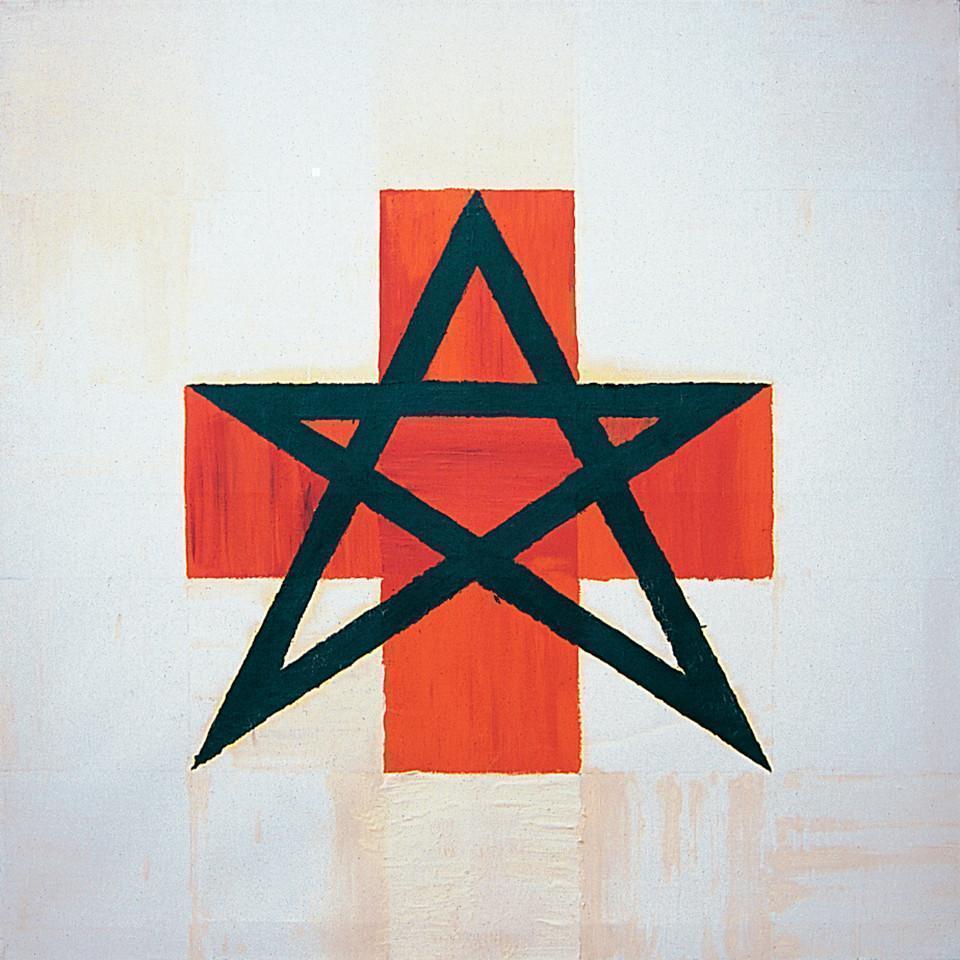Jerzy Truszkowski
untitled
Jerzy Truszkowski, untitled, 1993, oil on canvas, 150 × 150 cm
Collection II of the Arsenal Gallery in Białystok. Works donated to the Arsenal Gallery by the artist

Jerzy Truszkowski’s untitled painting (1993) consists of a red Greek cross with a superimposed black polygon reminiscent of a deformed pentagram. The three shorter points of the star are inscribed on the arms of the cross, the two longer ones reach the corners of the square in which the entire cross can be enclosed. The disciplined geometrical figures constitute an element of an equally rigorous composition subjected to the regular rhythm of twenty-five squares into which the surface of the canvas is divided. The squares were made by means of calm, long brushstrokes on thickly applied paint.
Symbols: swastikas, crosses, pentagrams and hexagrams have been present in Truszkowski’s oeuvre since the mid-1980s. At that time, he would cut them with a scalpel or a razor on his own body. He performed those acts of self-mutilation, infringing the contiguity of the skin and the integrity of the “I”, during calm, carefully staged actions. He often juxtaposed the signs on his body with ones shown on, for instance, a wall (e.g. during the performance Her Star for Konart, 1984). In the late 1980s, Truszkowski began to paint signs on canvas, arrange them in terracotta, or reveal by chipping plaster off a brick wall (e.g. during the exhibition Snow and Blood at the Arsenał Gallery in Białystok, 1993). More or less at the same time he began to explore the similarities between the motifs of the star or the cross and the schematically rendered human figure. The connection between the sign and the individual, a sign and the “I” seems important to the understanding Truszkowski’s actions. His practice of operating on signs bears the marks of an obsession. He multiplies them, looking for interconnections and rhythms; his collages Snow and Blood (1993), consisting of photographs documenting the aforementioned exhibition at the Arsenał Gallery, are constructed in this manner.
Truszkowski makes use of symbols associated with magic and religion, but also of those that occupy a very special place in the recent history (e.g. the emblems of the Polish and German air forces). All of them refer to definite orders, and thus to systems through which power is exercised and individuals are disciplined. By presenting symbolic signs in exhibition spaces or canvas surfaces, Truszkowski clearly points to mechanisms which rule the social order and regulate the lives of individual in a society. Importantly, his attitude to those symbols and the orders they represent is personal.
Scholars researching Truszkowski’s oeuvre indicate that he has always been an autonomous creator, strongly opposed to what was given beforehand. They interpret the acts of cutting symbols into his body as equating the violence against one’s own “I” with the violence wreaked on the individual by the social order. In this case, self-aggression is liberative; the gesture of mutilation is directed against the system, it deprives it of the power over the body and permits the individual to reign personal freedom. Symbols cut into the skin cease to be solely universal signs and become imbued with “private” meanings.
The personalisation of a symbol is particularly powerful in the photographs documenting the performances, or, more precisely, the photographs of a screen showing stills from film recordings of Truszkowski’s actions (the artist does not make the recordings themselves available for viewing). The diptych Caput Mortuum (1997) clearly shows the fusion of the artist/individual with the sign of the cross cut on his forehead. Truszkowski plays with meanings – caput mortuum (“dead head” in Latin) is also the red pigment used as a colouring agent in painting – thereby constructing a network of associations between blood, a cross and a skull which has a universal significance as a vanitas symbol. The centre of his action is the artist himself, with his “painting tool”, a scalpel, held in his raised hand. The act of self-mutilation as a gesture of transferring a sign from the social sphere to the private sphere raises a set of new questions concerning Truszkowski’s actions: his approach to self-destruction, suffering, pain, or death.
Izabela Kopania
translated from Polish by Klaudyna Michałowicz

PLAN YOUR VISIT
Opening times:
Thuesday – Sunday
10:00-18:00
Last admission
to exhibition is at:
17.30